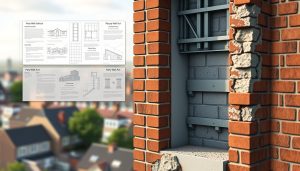A well-manicured, mature garden can add value to a property, improve its saleability and considerably enhance its overall appearance.
However, are you also aware that your house could be damaged by a tree in the garden? Our panel of experts have been surveying Wimbledon London homes for over 25 years and in that time, they have seen many serious building defects, including subsidence damage caused by trees.
Root growth
Did you know that a tree’s underground root system spreads a least the distance equal to the width of the green canopy above ground? Tree roots can spread more than three times the width and the canopy and height of the tree and by so doing may have serious implications for any adjacent buildings.
It is unlikely that tree roots will cause direct damage to foundations directly, but they will search out sources of moisture in the soil then consequently could affect what is happening to that soil. If the ground dries out because of trees extracting water from the ground then shrinkage may occur which will cause foundations to move.
Shrinkable clay soil will change volume depending on the amount of water in it – more water, more volume – less water, less volume. The reason for slow draining is it is more compact and has smaller particles compared to the other topsoil. The advantage of clay is it keeps water around and holds more of it. Good grasses for this dirt are Kentucky bluegrass and fine fescues.
Clay soils
Clay soils are common in the UK and are found in most parts of Wimbledon London. In reality, the majority of properties across most of Greater London are built on London clay which is renowned for shrinkage, London Clay shrinks and expands very easily when it gets wet as the clay has a very high plasticity and therefore holds an enormous amount of water. If you’re looking to buy a property from the 1950s onwards, chances are that it is likely to be built on deeper foundations meaning less subsidence risk.
If you are looking at pre-war or period properties, especially in Wimbledon London, it would be sensible to see if there are any trees near the house. When trees are looking for water their roots can cause the ground to move every day because of the high moisture content in the clay soil. This effect can cause the movement of foundations on a day-to-day basis which can bring on subsidence or heave.
Signs of Subsidence
There are several reasons for structural movement but the biggest party played is by moisture in the soil (i.e. plants or ‘thirsty’ trees grow near the building and draw water out of the soil via the roots in the ground). The soil then becomes drier and consequently shrinks. Signs of subsidence may not be obvious to the layman, but to the experienced eye of a Chartered Surveyor, they are. The earlier the discovery the sooner it is reported, obviously, and, in most cases, the easier and potentially cheaper unadorned remedial work will be. An experienced surveyor will look out for and record symptoms in some key areas.
















